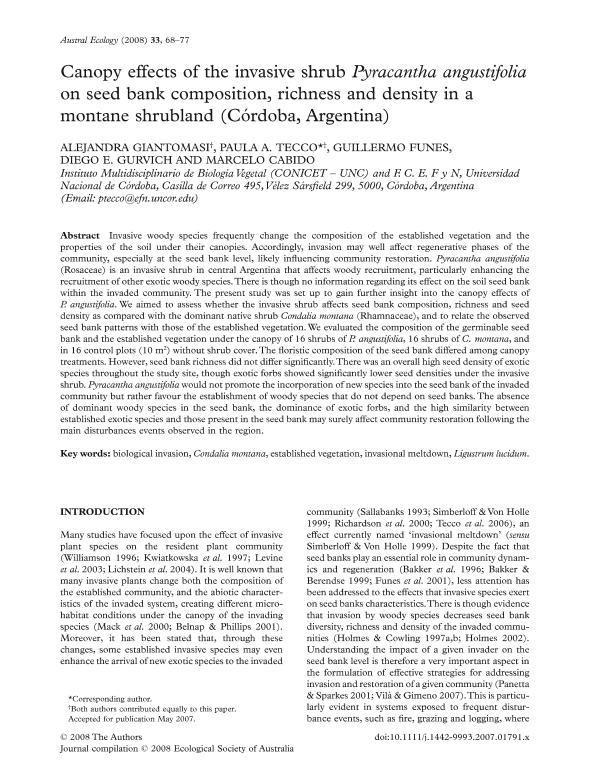Mostrar el registro sencillo del ítem
dc.contributor.author
Giantomasi, María Alejandra

dc.contributor.author
Tecco, Paula Andrea

dc.contributor.author
Funes, Guillermo

dc.contributor.author
Gurvich, Diego Ezequiel

dc.contributor.author
Cabido, Marcelo Ruben

dc.date.available
2017-10-25T12:52:53Z
dc.date.issued
2008-01
dc.identifier.citation
Giantomasi, María Alejandra; Tecco, Paula Andrea; Funes, Guillermo; Gurvich, Diego Ezequiel; Cabido, Marcelo Ruben; Canopy effects of the invasive shrub Pyracantha angustifolia on seed bank composition, richness and density in a montane shrubland (Córdoba, Argentina); Wiley; Austral Ecology; 33; 1; 1-2008; 68-77
dc.identifier.issn
1442-9985
dc.identifier.uri
http://hdl.handle.net/11336/27049
dc.description.abstract
Invasive woody species frequently change the composition of the established vegetation and the properties of the soil under their canopies. Accordingly, invasion may well affect regenerative phases of the community, especially at the seedbank level, likely influencing community restoration. Pyracantha angustifolia (Rosaceae) is an invasive shrub in central Argentina that affects woody recruitment, particularly enhancing the recruitment of other exotic woody species. There is though no information regarding its effect on the soil seedbank within the invaded community. The present study was set up to gain further insight into the canopy effects of P. angustifolia. We aimed to assess whether the invasive shrub affects seedbank composition, richness and seed density as compared to the dominant native shrub Condalia montana (Rhamnaceae), and to relate the observed seedbank patterns with those of the established vegetation. We evaluated the composition of the germinable seedbank and the established vegetation under the canopy of 16 shrubs of P. angustifolia, 16 shrubs of C. montana, and in 16 control plots (10 m2) without shrub cover. The floristic composition of the seedbank differed among canopy treatments. However, seedbank richness did not differ significantly. There was an overall high seed density of exotic species throughout the study site, though exotic forbs showed significantly lower seed densities under the invasive shrub. Pyracantha angustifolia would not promote the incorporation of new species into the seedbank of the invaded community but rather favour the establishment of woody species that do not depend on seedbanks. The absence of dominant woody species in the seedbank, the dominance of exotic forbs, and the high similarity between established exotic species and those present in the seedbank may surely affect community restoration following the main disturbances events observed in the region. <br />
dc.format
application/pdf
dc.language.iso
eng
dc.publisher
Wiley

dc.rights
info:eu-repo/semantics/openAccess
dc.rights.uri
https://creativecommons.org/licenses/by-nc-sa/2.5/ar/
dc.subject
Biological Invasion
dc.subject
Condalia Montana
dc.subject
Established Vegetation
dc.subject
Invasional Meltdown
dc.subject
Ligustrum Lucidum
dc.subject.classification
Conservación de la Biodiversidad

dc.subject.classification
Ciencias Biológicas

dc.subject.classification
CIENCIAS NATURALES Y EXACTAS

dc.title
Canopy effects of the invasive shrub Pyracantha angustifolia on seed bank composition, richness and density in a montane shrubland (Córdoba, Argentina)
dc.type
info:eu-repo/semantics/article
dc.type
info:ar-repo/semantics/artículo
dc.type
info:eu-repo/semantics/publishedVersion
dc.date.updated
2017-10-18T14:52:32Z
dc.identifier.eissn
1442-9993
dc.journal.volume
33
dc.journal.number
1
dc.journal.pagination
68-77
dc.journal.pais
Estados Unidos

dc.journal.ciudad
Hoboken
dc.description.fil
Fil: Giantomasi, María Alejandra. Consejo Nacional de Investigaciones Científicas y Técnicas. Centro Científico Tecnológico Conicet - Mendoza. Instituto Argentino de Nivología, Glaciología y Ciencias Ambientales. Provincia de Mendoza. Instituto Argentino de Nivología, Glaciología y Ciencias Ambientales. Universidad Nacional de Cuyo. Instituto Argentino de Nivología, Glaciología y Ciencias Ambientales; Argentina
dc.description.fil
Fil: Tecco, Paula Andrea. Consejo Nacional de Investigaciones Científicas y Técnicas. Centro Científico Tecnológico Conicet - Córdoba. Instituto Multidisciplinario de Biología Vegetal. Universidad Nacional de Córdoba. Facultad de Ciencias Exactas Físicas y Naturales. Instituto Multidisciplinario de Biología Vegetal; Argentina
dc.description.fil
Fil: Funes, Guillermo. Consejo Nacional de Investigaciones Científicas y Técnicas. Centro Científico Tecnológico Conicet - Córdoba. Instituto Multidisciplinario de Biología Vegetal. Universidad Nacional de Córdoba. Facultad de Ciencias Exactas Físicas y Naturales. Instituto Multidisciplinario de Biología Vegetal; Argentina
dc.description.fil
Fil: Gurvich, Diego Ezequiel. Consejo Nacional de Investigaciones Científicas y Técnicas. Centro Científico Tecnológico Conicet - Córdoba. Instituto Multidisciplinario de Biología Vegetal. Universidad Nacional de Córdoba. Facultad de Ciencias Exactas Físicas y Naturales. Instituto Multidisciplinario de Biología Vegetal; Argentina
dc.description.fil
Fil: Cabido, Marcelo Ruben. Consejo Nacional de Investigaciones Científicas y Técnicas. Centro Científico Tecnológico Conicet - Córdoba. Instituto Multidisciplinario de Biología Vegetal. Universidad Nacional de Córdoba. Facultad de Ciencias Exactas Físicas y Naturales. Instituto Multidisciplinario de Biología Vegetal; Argentina
dc.journal.title
Austral Ecology

dc.relation.alternativeid
info:eu-repo/semantics/altIdentifier/doi/http://dx.doi.org/10.1111/j.1442-9993.2007.01791.x
dc.relation.alternativeid
info:eu-repo/semantics/altIdentifier/url/http://onlinelibrary.wiley.com/doi/10.1111/j.1442-9993.2007.01791.x/abstract
Archivos asociados
